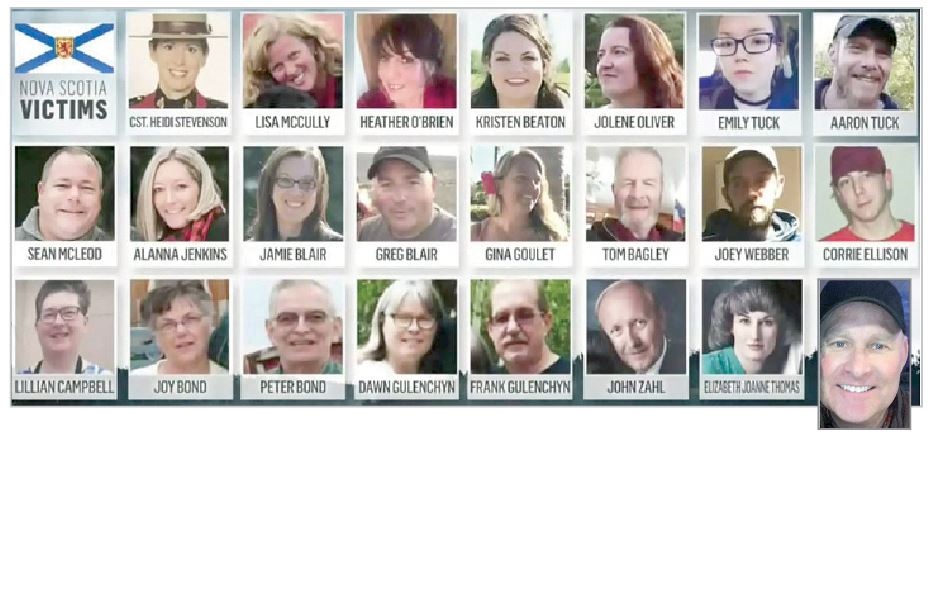2020 mass shooting in Nova Scotia, RCMP failures dominate inquiry’s final report
TORONTO – Massacre in Nova Scotia: a report holds the RCMP to its responsibilities, listing a long series of omissions by the Royal Canadian Mounted Police on the occasion of the massacre that saw the death of twenty-two people in April 2020 (in the pic above; the last on the right is the killer, Gabriel Wortman).
The Mass Casualty Commission (MCC) had been commissioned by the federal government to prepare a detailed report on the thirteen hours of absolute madness of Gabriel Wortman, the man – an unsuspected wealthy dentist – who, between 18 and 19 April 2020, did the worst massacre in Canadian history. The timeline of the events of the investigation, determined through interviews, medical records and forensic evidence – some of which found by the population – was officially presented today (you can read the whole report clicking here) and reconstructs the dynamics of the facts in minute detail.
The man killed his first 13 victims in the Portapique area, within 45 minutes, on the night of April 18, spent shooting and setting fires. Dressed as a police officer, driving a perfect replica of the RCMP car he built himself, Wortman continued to “leave” the police until the next day, April 19, when he killed 9 more people, including one RCMP agent caught in the final firefight with the dentist, who was killed by another agent.
After months of public hearings, hours of testimony and thousands of pages of evidence, the Mass Casualty Commission’s final report drafted by commissioners J. Michael MacDonald, Leanne Fitch and Kim Stanton is filled with scathing criticisms of the RCMP’s actions before, during and after the tragedy.
Since the beginning of the massacre, the commissioners write, the RCMP has failed to recognize the important role of eyewitness accounts in the field at Portapique on the night of 18 April. “Notably, the RCMP ignored information from members of the Portapique community that the perpetrator was driving an RCMP vehicle”. Information which, according to the report, was not transmitted to the police officers who responded in the following hours, nor to the population.
The commissioners note that many Portapique residents, including some of those killed, “put themselves in danger in their attempts to ensure the safety of their neighbors” as they left their homes to investigate fires and explosions occurring in the community. The report said the RCMP “underestimated” the role of community members and their eyewitness accounts, who had not only identified the gunman but also provided descriptions of his perfect replica of the RCMP car. According to the report, the RCMP had received three calls to 911 in Portapique on the night of April 18, half an hour after the first killing. But “gaps in the information captured and shared by those answering calls with those on patrol were the result of ineffective policies and practices of the Operational Communications Center (OCC)”.
Additionally, RCMP commanders reportedly failed to establish sufficient containment of the Portapique area, as the assassin escaped the area using a rough dirt road near a blueberry field. And there were also large gaps in informing citizens of the danger they were running with a killer in circulation: according to the report, in fact, “the RCMP was not prepared on how to best inform community members and carry out an evacuation large-scale civilian population from a ‘hot’ area while there was an active threat”. “A significant failure”, write the commissioners, “in implementing the priority of preserving lives”. Not even a warning message has ever been disseminated to the population: according to the Commission, “Alert Ready would have been the best tool available to warn the population”.
Not only. Information provided by the killer’s live-in partner, Lisa Banfield, indicating that Wortman was driving his RCMP dummy vehicle, reached investigators at approximately 7.30am on Sunday, April 19, but the RCMP did not inform the public of this fact, and the Wortman wore what appeared to be a police uniform until 10.17am, when he posted the information on Twitter: the hours delay “deprived” residents of an opportunity to protect themselves. According to the report, “(RCMP) has moved slowly to convey key information”, the commissioners write, “and their efforts have often been too little, too late”. That key information, the commissioners said, was not shared quickly or accurately by commanding officers in Nova Scotia or the national headquarters, or with other emergency responders active in the province.
But the omissions also concern the phases following the massacre. Indeed, the commissioners underline the failures of both the police and the provincial government to provide families with timely information and adequate mental health services after the events. The consequences, they write, were “a health deficit and a public health emergency”.
Finally, the commissioners harshly criticized the RCMP leadership for failing to review the actions of the armed forces in the aftermath of the tragedy. “More than two years after the event” they write, “the RCMP leadership has done little to gauge its response to the worst mass shooting in Canadian history”. In a nutshell, despite knowing it was wrong, the RCMP continues to persevere in the error of maintaining a system that obviously doesn’t work.
Trudeau: “It is clear that something needs to change”. MCC: “Weapons to be banned”
“It is clear that something needs to change”: this is how Prime Minister Justin Trudeau commented on the final report of the Mass Casualty Commission (MCC) on the massacre in Nova Scotia. “We will take the time to properly understand the recommendations, the conclusions and the opportunities that the Commission has proposed us to seize. There is no doubt that there must be changes, and there will be, but we will take the time to fix them, Trudeau added.
There are 130 recommendations – half of which are aimed at a radical reform of the RCMP – contained in the Commission report, which also discusses the need for changes regarding the possession of firearms and cross-border smuggling of weapons and ammunition in Canada. The Commission recommends amending the Penal Code to ban all semi-automatic pistols, semi-automatic rifles and shotguns that discharge centerfire ammunition or can accept detachable magazines with a capacity exceeding five rounds, as well as to ban the use of a magazine with multiple of five shots.
The report also sided with critics of the nation’s public emergency alert system, Alert Ready. The commissioners have indeed written that the responsibility for alerting the public must be shifted from a private provider. Currently, the system is maintained by an Ontario-based company that owns the software and manages it – in fact – on behalf of the federal government. The commissioners are recommending that all levels of government conduct a review of public alerts to determine how the Alert Ready system can be reformed to meet the legal responsibility to warn people of emergencies.




